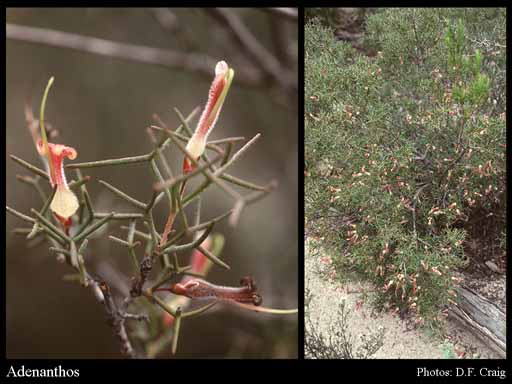- Reference
- Nov.Holl.Pl. 1:28 (1805)
- Name Status
- Current

Scientific Description
Common name. Stick-in-jug. Family Proteaceae.
Habit and leaf form. Small trees, or shrubs (bark smooth, rarely warty); evergreen. To 0.3–3 m high. Mesophytic, or xerophytic. Heterophyllous, or not heterophyllous. Leaves small to medium-sized; alternate; usually spiral; leathery; petiolate to sessile; non-sheathing; glands present at leaf tip or at tips of leaf lobes or over leaf surface, glandular cavities lacking internal hairs; edgewise to the stem, or with ‘normal’ orientation; simple, or compound; epulvinate; pinnate. Leaf blades when simple, dissected, or entire; flat, or solid; terete; linear, or ovate, or obovate, or oblong, or elliptic, or obtriangular. Mature leaf blades adaxially glabrous, or pubescent, or woolly; abaxially glabrous, or pubescent, or woolly. Leaves without stipules. Leaf blade margins entire. Leaves without a persistent basal meristem. Leaf anatomy. Hairs present, or absent. Stem anatomy. Secondary thickening developing from a conventional cambial ring.
Reproductive type, pollination. Fertile flowers hermaphrodite. Unisexual flowers absent. Plants hermaphrodite. Entomophilous, or ornithophilous, or pollinated by unusual means (small marsupials).
Inflorescence and flower features. Flowers solitary, or aggregated in ‘inflorescences’ (depending on interpretation); terminal, or axillary; not in pairs subtended by a common bract; in racemes. Inflorescences terminal, or axillary; a short, 1-flowered raceme; with involucral bracts. Involucral bracts persistent (numerous, scale-like). The fruiting inflorescence not conelike. Flowers shortly pedicellate to sessile; small to medium-sized; somewhat irregular, or very irregular; zygomorphic. The floral asymmetry involving the perianth, or involving the perianth and involving the androecium. Flowers 4 merous; cyclic; tetracyclic. Floral receptacle developing a gynophore, or with neither androphore nor gynophore. Free hypanthium absent. Hypogynous disk present; extrastaminal; of separate members (comprising 4 glands, alternating with the tepals). Perianth of ‘tepals’; 4; 1 -whorled; joined (tubular); hairy (hirsute outside, bearded inside); green and cream, or cream and blue, or cream, or yellow, or orange, or red, or pink, or purple. Androecial members definite in number. Androecium 4. Androecial members adnate (to tepal claws); all equal, or markedly unequal; free of one another; 1 -whorled. Androecium exclusively of fertile stamens, or including staminodes. Staminodes 1; representing the posterior median member. Stamens 3, or 4; reduced in number relative to the adjacent perianth, or isomerous with the perianth; filantherous (however the filament is fused to the adjacent sepal claw for almost the entire length of the filament), or with sessile anthers (apparently). Anthers basifixed; non-versatile; dehiscing via longitudinal slits; introrse; four locular; tetrasporangiate. Pollen grains moderate in size, triangular. Gynoecium 1 carpelled. The pistil 1 celled. Gynoecium monomerous; of one carpel; superior. Carpel stylate; apically stigmatic. Style much longer than the perianth, looped and protruding through an adaxial slit in the distal part of the tepal claw in late bud; pollen presenter conical or flattened and elliptic. Carpel 1 ovuled. Placentation marginal, or apical. Ovary sessile. Styles hairy, or hairless. Ovules funicled, or sessile; horizontal; non-arillate; hemianatropous.
Fruit and seed features. Fruit falling from the plant before the next growing season; non-fleshy. The fruiting carpel indehiscent; an achene (ellipsoid, released from the involucre when the bracts dry and spread out). Seeds non-endospermic. Embryo well differentiated. Cotyledons 2(–3). Embryo straight.
Special features. Stamens inserted within a concavity near the end of a perianth segment. Staminodes free of the stigma.
Geography, cytology, number of species. Native of Australia. Endemic to Australia. Australian states and territories: Western Australia, South Australia, and Victoria. South-West Botanical Province. N=13.
Etymology. From the Greek meaning "gland" and "flower", referring to the glands at the base of the ovary.
Taxonomic Literature
- Wheeler, Judy; Marchant, Neville; Lewington, Margaret; Graham, Lorraine 2002. Flora of the south west, Bunbury, Augusta, Denmark. Volume 2, dicotyledons. Australian Biological Resources Study.. Canberra..